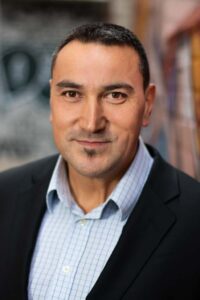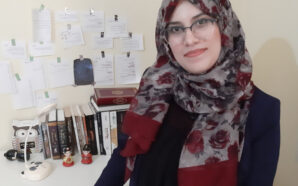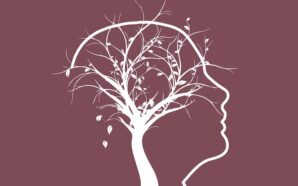This interview is a part of Ananke's special spotlight edition celebrating The Fred Hollows Foundation's 30 years of change making. You can check out the magazine here.
Brandon, you have unique role – not just heading public policy and advocacy at the Fred Hollows Foundation – you are also a stakeholder representing the vision impaired and blind community. Can you tell us a bit about yourself?
I’ve actually been working in the eye health sector for 15 plus years now. Probably half of my time has been spent more in the blindness and disability areas from the human rights side. And then the last probably half of that time has really been in the eye health side of the spectrum. But really, I like to sort of see it as part of the entire picture around eye health from blindness through to treatment.
My background in terms of formal training is in social sciences and policy, so I’ve always worked in this space. I’m also blind myself. I have a condition that I was born with. But I’m the only person in my family with this condition, even across all my extended family. I only started having my vision deteriorate, probably in my 20s. So when I was about 26 or27, I was still able to drive, play rugby and all sorts of things. But then, my vision started to deteriorate pretty quickly. Over the following ten years, in my mid 30s, my vision deteriorated. Now I only have light perception and it’s not very clear. It’s defined as sort of like perceptional blindness. So I guess from that from that angle I’ve got a bit of an interest in both the experience of living with blindness and an affinity towards the work that we do here at the foundation, which is a primarily around prevention and treatment.
To be able to restore sight for people who haven’t had access to eye health services and treatments in the past. It is quite a unique insight I think.
You’re talking about policy. What is the importance of that connection between policy and advocacy as far as public health is concerned? And of course, by extension, eye health and bringing in your own experiences to it as well.

The Fred Hollows Foundation’s Head of Public Policy and Advocacy Brandon Ah Tong
I like to think of the role of policy as being the kind of high level settings or parameters that try to guide actions towards a particular outcome. The work that I’ve been doing for a long time is really about trying to move, create, adjust and you know push government level policy towards the particular settings that will either improve access to eye health or try to provide clarity around, for example financing. How eye health should be financed or how can we improve the workforce. I sort of see that high level settings provide such direction for programmatic or project based as well as other public health interventions.
So that’s the role I see of policy and of course you need the macro and the micro (aspects). They go hand in hand and work together. On the one hand, it’s really important to try and provide policy guidance or to advocate for a certain policy, but what really is important is how that policy is implemented in practice. My own particular interest and I think my own sort of skills and background is towards the macro level; a higher level of settings and in terms of why it’s important to do that for development. Why it’s important to have that macro or that policy level is because if you’re able to find a system level or systemic way of creating change across multiple settings, across multiple actors, I kind of see that as a good way or efficient way of providing faster access to change.
This is why I find myself gravitating towards policy work and if I just touch on the advocacy point as you sort of mentioned before. Advocacy is really the act of persuading or influencing decision makers towards creating those changes or pushing towards particular settings. Here at the Fred Hollows Foundation, we talk about advocacy being a managed and deliberate process. You need to know what you’re aiming to achieve, need to have a clear sense of who those decision makers are. You know, what information or evidence would help to persuade them. But you also need to understand why.
You’re looking to make those changes, and I think advocacy is really the art of trying to bring all these things together to create cohesive change.
If I think about my own role here at the Fred Hollows Foundation. My role is the head of public policy and advocacy. It is really at a global or multilateral level. I often think of or talk about the work that we do in terms of normative change and by normative change, I mean in terms of trying to look at how we reframe how we talk about eye health. How we talk about blindness and vision impairment. You know this space that we see ourselves in and I can give you an example of what I mean by that. If you go back, let’s say to five years. The Sustainable Development Goals (SDGs) had been released in 2015. We have these 17 high level goals, 169 targets that sit underneath those and then there’s like another 232 indicators. We can definitely see eye health across many, many goals and see how it contributes to them. But the reality is the world hasn’t really seen eye health in those terms before.
At the Fred Hollows Foundation, my team is working with others in the sector, like the International Agency for the Prevention of Blindness and the World Health Organization as well. It’s really been about (placing) eye health within the SDG’s. There has also been research done. We have supported the inclusion of eye health in the SDGs in a resolution passed by the World Health Assembly back in 2020, which is actually the decision making body for the World Health Organization. We also supported work with The Lancet Global Health Commission on Global Eye Health that really tried to take a step forward and seeing eye health as a development issue. The UN General Assembly also adopted its first standalone resolution that was dedicated to eye health itself.
The focus was on how eye health can be an enabler to accelerating progress towards achieving the SDG’s. So now you can see five years ago eye health wouldn’t be seen in that light at all. Now you can see how eye health is being reframed. There are resolutions at the global level that talk about how eye health is relevant for the SDG’s and that normative shift is coming back to the conversation about policy. What our team is really trying is to create that normative change and also embed this vision (of eye health as an enabler) in policy as part of our implementation strategy.
How did your journey at the Fred Hollows Foundation began.
I have been working at the Foundation for over six years now. Before working at the Fred Hollows Foundation, I worked for the national body for eye health and vision care, which is called Vision 2020 Australia. That organization focuses domestically, but it also has a role in advocating and providing guidance around what the Australian government does in the region.
So there’s a global component there as well and I was the Director of Policy and Advocacy at the Vision 2020 Australia and Fred Hollows Foundation is a member of Vision 2020. I had worked with the Foundation for quite a bit. And at the time, there was an opportunity to move to the Foundation to do some of this more, more of the global multilateral work. I jumped at that opportunity.
You need different people with different skills. They have different interests with different experiences and backgrounds to sort of come together. I gravitate towards more systemic work so the opportunity to try and shape global policy was hugely exciting for me and that’s how I started working with the Foundation.
The term human rights based policy is a critical term that needs to be understood and it is essential that work to be implemented is done through this lens. Understanding this approach is important, wouldn’t you agree?
This is really a good question. I see human rights as something quite evolving. We have international human rights treaties and international human rights norms that go back 70 years through the United Nations system itself. On the one hand, it seems that they are quite static, but from another perspective. How you actually embed a human rights approach to your work evolves over time. By that I mean if you look at the central tenant of the Sustainable Development Goals, it’s around this concept of leaving no one behind. Now that in itself is a human rights concept. For us, how we look at taking a human rights approach, it’s about ensuring that you know different.
People, whether you have money or you don’t have money, where you live, your ethnicity, your ethnic background, your gender whether you’re a man or a woman, or otherwise, we have a role to ensure that any of those backgrounds or those attributes do not interfere with the way in which you have access to eye health and I care. Taking a human rights based approach is our way of ensuring that availability and access is open to everyone. We will try and put specific things in place to make sure that people don’t miss out or people aren’t left behind. So again, I think by taking a human rights based approach at the Fred Hollows Foundation, we are making it our responsibility, an obligation to try and do whatever we can to make sure that people from different walks of life or different backgrounds, that everybody has access to eye care services.
It also extends to the work especially working with our partners and countries. Our role is really kind of trying to create systemic change and health system change. We work with partners around training, health professionals, so that same concept of ensuring that people who need our health services can get access to care. That same idea flows through to who can we help to target training doctors and community health workers and nurses and so forth.
Talking about health workforce, about 70 percent are made-up of women, but only 25 percent of all health workers are in those more senior roles, which by extension means that we need to do something specific about trying to ensure that women’s leadership is recognized. And, that we create pathways for women to not just get into the workforce, but also find routes to leadership positions. Therefore, in taking a human rights based approach, we are trying to be deliberate about what we do in our work to ensure that people are included.
This has been an enlightening discussion and unfortunately I come to the last question. The foundation is celebrating 30 years of change making work. Do you have any last words?
Interestingly, Professor Fred Hollows, the man himself actually comes from the same town from where I hail in New Zealand. It’s a small town called Dunedin. This is a very nice link with Professor Fred, himself. But you know, I think we as a foundation really take in the way with which Professor Hollows approached his work. I mean, he was an ophthalmologist and he really championed the need to go further, to take the next meaningful steps and meaningful action.
So I think working for the foundation, which is an embodiment of Professor Hollows himself and his personality is really exciting because our culture is that we need to try and push ourselves harder to do more and do better. So I find that, really inspiring and quite humbling to be part of its culture. There are so many statistics that we can talk about the work we do. We have restored sight for over three million people. We have provided antibiotics for more than 200 million people. Even if we think about the last five years, we have trained more than 730 surgeons. More than 230,000 community health workers have been trained. So for me again it comes back the pride of being part of an organization that strives to do more and do better.
The interview has been lightly edited for clarity.
Images courtesy: The Fred Hollows Foundation











